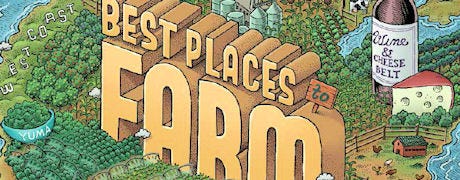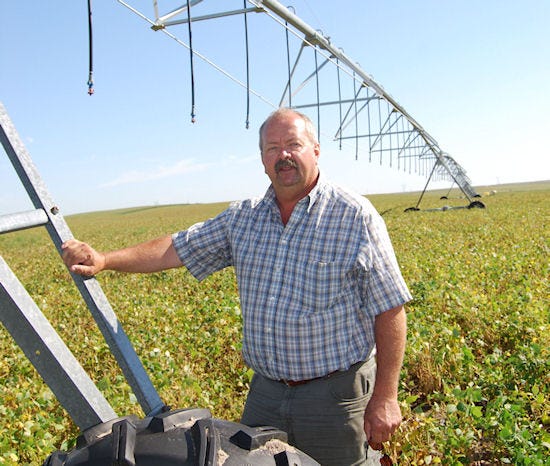October 16, 2014

By Bryce Knorr and Mike Wilson
When life gives you lemons, make lemonade. Tony Debevc had grapes, so he made wine.
Northeast Ohio, 45 miles from Cleveland, may seem light-years from Napa Valley. While it's not Santa Barbara, Lake County has a coast of its own on Lake Erie. And though it's the smallest county in the Buckeye state, it's also the most profitable, good enough to rank No. 2 on our list of Best Places to Farm.
A big reason for the area's profitability comes from wine. Debevc's parents and grandparents grew grapes, but for products like jelly. Lake County produced wine dating back to the 1800s, but the wineries that survived Prohibition died out in the 1960s.

Rust Belt farmers foster consumer interest in ag while Western Corn Belt farmers find profitability in irrigated crops
Debevc renewed the tradition, starting Debonné Vineyards in 1971, capitalizing on the region's unique climate and soils to grow varieties the California wineries couldn't. But he adopted a page from the Napa playbook by offering wine for tasting and consumption on the farm. That was uncommon in the eastern U.S., but was allowed by Ohio's more liberal alcohol laws. As a result, the 170-acre Madison farm became a destination.
In addition to wine, Debonné offers atmosphere. That includes music, tours, a hot air balloon rally, classic car show and even chances to bring pets, known as "Woof Wednesdays." The result is a year-round attraction.
"The wine always tastes better at the winery, because you're having a great time," he says.

"If Mother Nature leaves us alone, we'll average 200- to 220-bushel corn every year with irrigation," says Nebraska farmer Roric Paulman.
With some 30 wineries in the area, the business is booming. And it offset a downturn in Lake County's other big agricultural sector, commercial nurseries. That industry boosted Lake County to 21st in our last survey, based on data from 2007, before the housing bust. Agritourism could help the region weather severe damage to vineyards from last winter's deep freeze.
Diversification and high-value enterprises played a key role in keeping agriculture profitable across the Rust Belt, from Wisconsin into upstate New York. A better name for the region these days might be the Wine and Cheese Belt. While vineyards are a mainstay of the Finger Lakes in New York, they've established a following in Michigan and Wisconsin, too.
Dairy is strong throughout, benefiting from the Greek yogurt explosion that began in New York. More dairies are entering the high-end cheese business as well, and exports are booming, one reason the value of milk sold in the U.S. was greater than corn.
While soils in the region may not support corn and soybean yields found in Iowa and Illinois, they do permit a wide range of crops, including fruits and vegetables. And even corn and beans are finding their way into some unusual locales.
Clinton County, N.Y., was the third-highest-rated county in the region. Nestled between Lake Champlain on the east, the Adirondacks on the west and Canada to the north, it's a place that large-scale 20th-century production practices overlooked until recently.
But thanks to tiling improvements and consolidation of small fields, corn acreage tripled from 2000 to 2012 to supply a large poultry operation. The total harvested for grain is still small, compared to, say, McLean County, Ill. But the 10,800 acres help provide a multi-legged base of support, along with fruit orchards and dairy.
That's another key for these states. While they're known for cities like the Big Apple, agriculture remains big business.
"There's a lot of country in New York," says Peter Hagar, of the Cornell Extension in Plattsburg, N.Y. "Farming is one of our biggest industries. It's what we're good at."
Irrigation and feedlots power profits in Western Grain Belt
Despite a devastating drought, some Western feedlots and irrigators made handsome financial returns from 2007 to 2012. While challenged by high feed costs, many feedlots took advantage of cheaper cattle coming off parched pastures, turning a profit while keeping fixed costs relatively low.
Meanwhile, crop farmers with adequate water supplies and efficient irrigation profited from good yields and high prices.
Consistent production and good transportation also helped, says Roric Paulman, who farms near Sutherland, Neb. "There have been a whole host of things that have been really good here," he says. "This area is heavily irrigated and escaped the bad weather the past several years with significant irrigated corn yields. If Mother Nature leaves us alone, we'll average 200- to 220-bushel corn every year with irrigation.
"We're also within about 100 miles of six ethanol plants, and that impact on basis has been huge," he says. "Our basis at harvest, historically, has been up to 25 under. But in the last three out of five years, we traded 25 to 30 cents over basis."
Interstate 80 cuts a ribbon border to border through the state, allowing good truck access. Farmers have access to both the Union Pacific and Burlington Northern railroads. But the North Dakota oil fields are causing rail shortages that impact areas as far south as Nebraska. "We can't get cars," says Paulman. "The elevators and co-ops that have 100-unit cars are screaming. We can't get wheat out of this country."
Another key to demand is livestock; there's 1 million head of cattle on feed within a 100-mile radius of southwest Nebraska. While feedlot managers faced higher costs, they generally pulled through the past five years unscathed. "The same guys who own feedlots also have huge irrigated potato investments to diversify revenue streams," notes Paulman.
A lot of calves moved early into feedlots due to the drought, and cull cow prices stayed pretty firm, especially in 2012, so feedlot profit and cull cow sales might be a factor in profitability for the region, says Mike John, past president of the National Cattlemen's Beef Association and director of health track operations at MFA, a farm supply and marketing co-op.
"Irrigated corn in Nebraska has been unbelievably profitable," he adds. "Irrigation, selling lots of drought cows, and placing younger calves in feedlots and keeping those lots filled to capacity all factored in to profitability."
Did you miss a story in our Best Places to Farm series?
Exclusive Study: Best Places to Farm
Do You Live in one of Farm Futures' 'Best Places to Farm'?
Best Places to Farm: Northern Plains and Southeast Boast Energy, Poultry Profitability
Best Places to Farm: West Coast, Pacific Northwest Flaunt High Returns and Hot Demand
You May Also Like




